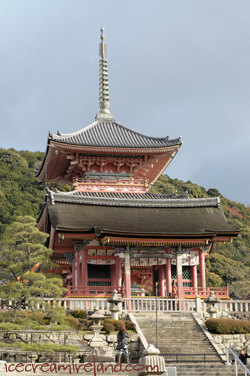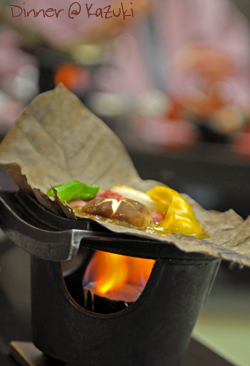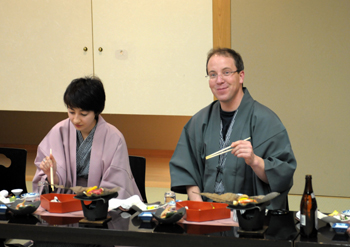 We took the Bullet Train from Tokyo down to Kyoto, for a change of scenery and a bit of more traditional culture. Kyoto, which means “capital,” was indeed the capital of Japan until 1868.
We took the Bullet Train from Tokyo down to Kyoto, for a change of scenery and a bit of more traditional culture. Kyoto, which means “capital,” was indeed the capital of Japan until 1868.

Since it survived World War II relatively unscathed from the wide-spread American bombing, it has many more old buildings and temples than Tokyo.
Our first outing was to the Kiyomizu Temple, a Buddhist temple founded in 798. It’s a large complex, with many little temples and a waterfall with holy water, which comes down in three streams and which you can drink for wisdom, health, and longevity. That’s the idea, anyway, and I was happy enough to give it a try.
I also visited the Kyoto National Museum, where they had a few beautiful paintings, exhibitions on court culture, and an exhibition on the Japanese film industry (many of the early films were made in Kyoto).
We stayed at Ryokan Kazuki, and took the waters there before dinner, enjoying a traditional Japanese bath. It’s quite relaxing, and it helps get in the mood for an evening in of eating (see below).
Dinner was a formal Kaiseki meal at the ryokan. There was no shortage of food. Here’s an idea of the courses, courtesy of Wikipedia, and it sounds about right:
Sakizuke: an appetizer similar to the French amuse-bouche.

Hassun: the second course, which sets the seasonal theme. Typically one kind of sushi and several smaller side dishes.
Mukozuke: a sliced dish of seasonal sashimi.
Takiawase: vegetables served with meat, fish or tofu; the ingredients are simmered separately.
Futamono: a “lidded dish”; typically a soup.
Yakimono: Broiled seasonal fish.
Su-zakana: a small dish used to clean the palate, such as vegetables in vinegar.
Hiyashi-bachi: served only in summer; chilled, lightly-cooked vegetables.
Naka-choko: another palate-cleanser; may be a light, acidic soup.
Shiizakana: a substantial dish, such as a hot pot.
Gohan: a rice dish made with seasonal ingredients.

Ko no mono: seasonal pickled vegetables.
Tome-wan: a miso-based or vegetable soup served with rice.
Mizumono: a seasonal dessert; may be fruit, confection, ice cream, or cake.
I can’t believe how much I’ve eaten on this trip, and how much I have liked it!











